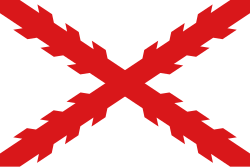Republiken Västra Florida
| Republiken Västra Florida | ||||
| State of Florida (Free and Independent Republic of West Florida) (engelska) | ||||
| ||||
Flagga | ||||
| Republiken Västra Florida, idag uppdelat mellan tre delstater. | ||||
| Huvudstad | St. Francisville | |||
| Statsskick | Republik | |||
| Sista guvernör | Fulwar Skipwith | |||
| Bildades | 23 september 1810 | |||
| Upphörde | 27 oktober 1810 | |||
| – upphörde genom | Annektering av USA | |||
| Idag del av | ||||
Republiken Västra Florida (engelska Republic of West Florida) var en kortlivad republik som existerade i cirka tre månader 1810. USA och Spanien förde under en tid förhandlingar gällande området. Under tiden etablerade sig amerikanska och engelska nybyggare i området och dessa motsatte sig den spanska kontrollen över kolonin. Den 23 september 1810 stormas den spanska garnisonen i Baton Rouge av rebeller som reser den nya republikens flagga, kallad Bonnie Blue Flag, en ensam vit stjärna mot en blå bakgrund, över garnisonen.
Gränserna till Republiken Västra Florida utgjordes av områden söder om 31:a breddgraden, väster om Perdidofloden, öster om Mississippifloden, men norr om Pontchartrainsjön. Den södra gränsen utgjordes av Mexikanska golfen. Huvudstaden var St. Francisville. Konstitutionen var till stor del baserad på USA:s konstitution. Enligt denna skulle områdets officiella namn vara Staten Florida (engelska State of Florida). Trots namnet så utgjorde republikens områden inget av dagens Florida. Den första, och enda, guvernören av republiken var Fulwar Skipwith.
Den 27 oktober 1810 deklarerade USA:s president James Madison att republiken ansågs vara en del av Louisianaköpet (se även USA:s territoriella expansion) och annekterade området. Fulwar Skipwith svor att han var villig att dö i försvar av “den ensamma stjärnan” (refererande till republikens flagga) men till slut accepterade han dock annekteringen.
Källor
- Den här artikeln är helt eller delvis baserad på material från engelskspråkiga Wikipedia, tidigare version.
Media som används på denna webbplats
Författare/Upphovsman: Ningyou., Licens: CC BY-SA 3.0
Flag with the cross of Burgundy (saltire). Also named Cross of Burgundy flag. It was used in the Catholic Monarchy and in its viceroyalties such as New Spain and Peru. It was also used by Spain as a military or king's prosonal flag. Used by the Carlist movement.
Författare/Upphovsman: Ningyou., Licens: CC BY-SA 3.0
Flag with the cross of Burgundy (saltire). Also named Cross of Burgundy flag. It was used in the Catholic Monarchy and in its viceroyalties such as New Spain and Peru. It was also used by Spain as a military or king's prosonal flag. Used by the Carlist movement.
Created according to the PNG version, which was slightly crooked. I used the following dimensions: r=star's radius, flag width=6r, flag height=4r
--Pumbaa 19:41, 29 March 2006 (UTC)Digital reproduction of the Star Spangled Banner Flag, the 15-star and 15-stripe U.S. garrison flag which flew over Fort McHenry following the Battle of Baltimore in the War of 1812. Seeing the flag during the battle, and again the following morning, inspired Francis Scott Key's song The Star-Spangled Banner, now the U.S. national anthem. During the battle a smaller "storm flag" was flown; it was replaced by this larger flag early the next morning, which is the flag Key saw then. This larger flag is now displayed at the National Museum of American History in Washington, D.C. For several decades it remained in the family of Fort McHenry's commanding officer, before being given to the Smithsonian in 1912. The family cut pieces out of the flag from time to time as gifts.
The original flag was 42 feet long and 30 feet high, with each stripe being about two feet, and the stars being about two feet in diameter. It was made by Mary Young Pickersgill and her assistants. More info on the original dimensions here. The stars seem to mostly point to the side, except for one (the bottom right) which points down. One star has been cut out of the actual flag, so I'm guessing that originally pointed to the side as well (Fort McHenry flies a flag (File:Ft mchenry 15starflag.jpg) with a similar star pattern, but it looks like they are all to the side, and the other dimensions look similar to a modern flag). I guesstimated other dimensions and star positions based on File:Star-Spangled-Banner-1908-1919.jpg; the union (blue area) looks to be about 19 feet wide. The star rows look to be evenly distributed; i.e. the distance between the top/bottom edges and the center of a star row looks to be about the same as the distance between two (centers of) rows. Not so left-to-right; they are pretty close to the right edge and even closer to the hoist side. Also available here, page 12.




